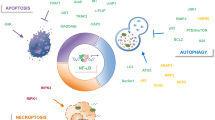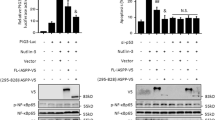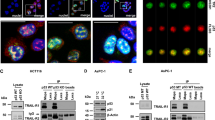Abstract
Nuclear factor-κB (NF-κB) promotes cell survival by upregulating expression of anti-apoptotic genes, a process that is antagonized by inhibitors of κB (IκB) factors1. The only NF-κB family member known to be mutated in human cancer is NF-κB2 p100 (ref. 2), a factor with IκB activity. Here, we report the isolation from irradiated mouse tumour cells of a complex that induces caspase-8 activity in cell-free assays and identify p100 as an essential component of this complex. Expression of p100 profoundly sensitizes cells to death-receptor-mediated apoptosis through a pathway that is independent of IκB-like activity. The carboxyl terminus of p100 contains a death domain3 that is absent from all known tumour-derived mutants. This death domain mediates recruitment of p100 into death machinery complexes after ligand stimulation and is essential for p100's pro-apoptotic activity. p100 also sensitizes NIH3T3 cells to apoptosis triggered by oncogenic Ras, resulting in a marked inhibition of transformation that is rescued by suppression of endogenous caspase-8. These observations thus identify an IκB-independent apoptotic activity of NF-κB2 p100 and help explain its unique tumour suppressor role.
This is a preview of subscription content, access via your institution
Access options
Subscribe to this journal
Receive 12 print issues and online access
$209.00 per year
only $17.42 per issue
Buy this article
- Purchase on Springer Link
- Instant access to full article PDF
Prices may be subject to local taxes which are calculated during checkout




Similar content being viewed by others
References
Baldwin, A. S. J. Clin. Invest. 107, 241–246 (2001).
Rayet, B. & Gelinas, C. Oncogene 18, 6938–6947 (1999).
Feinstein, E., Kimchi, A., Wallach, D., Boldin, M. & Varfolomeev, E. Trends Biochem. Sci. 20, 342–344 (1995).
Ding, H.-F. et al. J. Biol. Chem. 275, 38905–38911 (2000).
Varfolomeev, E. E. et al. Immunity 9, 267–276 (1998).
Juo, P., Kuo, C. J., Yuan, J. & Blenis, J. Curr. Biol. 8, 1001–1008 (1998).
Vincenz, C. & Dixit, V. M. J. Biol. Chem. 272, 6578–6583 (1997).
Zhou, Q. et al. J. Biol. Chem 272, 7797–7800 (1997).
Wu, M. et al. EMBO J 15, 4682–4690 (1996).
Liu, Z.-G., Hsu, H., Goeddel, D. V. & Karin, M. Cell 87, 565–576 (1996).
Beg, A. A. & Baltimore, D. Science 274, 782–784 (1996).
Van Antwerp, D. J., Martin, S. J., Kafri, T., Green, D. R. & Verma, I. M. Science 274, 787–789 (1996).
Wang, C. Y., Mayo, M. W. & Baldwin, A. S. Jr Science 274, 784–787 (1996).
Kim, K. E. et al. Oncogene 19, 1334–1345 (2000).
Solan, N. J., Miyoshi, H., Carmona, E. M., Bren, G. D. & Paya, C. V. J. Biol. Chem. 277, 1405–1418 (2002).
Kischkel, F. C. et al. EMBO J. 14, 5579–5588 (1995).
Ashkenazi, A. & Dixit, V. M. Science 281, 1305–1308 (1998).
Xiao, G., Harhaj, E. W. & Sun, S. C. Mol. Cell 7, 401–419 (2001).
Cogswell, P. C., Guttridge, D. C., Funkhouser, W. K. & Baldwin, A. S. Oncogene 19, 1123–1131 (2000).
Green, D. R. & Evan, G. Cancer Cell 1, 19–30 (2002).
Zhang, J., Chang, C. C., Lombardi, L. & Dalla-Favera, R. Oncogene 9, 1931–1937 (1994).
Thakur, S. et al. Oncogene 9, 2335–2344 (1994).
Chang, C. C., Zhang, J., Lombardi, L., Neri, A. & Dalla-Favera, R. Mol. Cell. Biol. 15, 5180–5187 (1995).
Senftleben, U. et al. Science 293, 1495–1499 (2001).
Caamano, J. H. et al. J. Exp. Med. 187, 185–196 (1998).
Franzoso, G. et al. J. Exp. Med. 187, 147–159 (1998).
Eng, J. K., McCormick, A. L. & Yates, J. R. I. J. Am. Soc. Mass Spectrom. 5, 976–989 (1994).
Ory, D., Neugeboren, B. & Mulligan, R. Proc. Natl Acad. Sci. USA 93, 11400–11406 (1996).
Finco, T. S., Beg, A. A. & Baldwin, A. S. Jr. Proc. Natl Acad. Sci. USA 91, 11884–11888 (1994).
Acknowledgements
We thank A. B. Rabson for p100, p80HT and p52 cDNA constructs; S. W. Lowe for pBabe-Ras; J. Yuan for pBabe-CrmA, rat anti-caspase-8 serum and the HT1080 cell line; R. Mulligan for the 293GPG cell line; D. Kirby and R. Robinson for mass spectrometry. H.-F.D. also thanks W. A. Maltese for support and K. C. Yeung for stimulating discussions. This work was supported in part by a grant from the National Institutes of Health (D.E.F.) and the Howard Temin Award from the NCI (H.-F.D.).
Author information
Authors and Affiliations
Corresponding authors
Ethics declarations
Competing interests
The authors declare no competing financial interests.
Supplementary information
Supplementary figures
Figure S1. Isolation of a p100-containing complex with caspase-inducing activities. the p53-/- extracts using rat antiserum against caspase-8. Normal rat serum was (PDF 249 kb)
Figure S2. Analyses of NF-κB cellular localization and DNA-binding activity.
Rights and permissions
About this article
Cite this article
Wang, Y., Cui, H., Schroering, A. et al. NF-κB2 p100 is a pro-apoptotic protein with anti-oncogenic function. Nat Cell Biol 4, 888–893 (2002). https://doi.org/10.1038/ncb872
Received:
Revised:
Accepted:
Published:
Issue Date:
DOI: https://doi.org/10.1038/ncb872
This article is cited by
-
p52 signaling promotes cellular senescence
Cell & Bioscience (2022)
-
Tumor-suppressor NFκB2 p100 interacts with ERK2 and stabilizes PTEN mRNA via inhibition of miR-494
Oncogene (2016)
-
Proteomic screen reveals Fbw7 as a modulator of the NF-κB pathway
Nature Communications (2012)
-
The unexpected role of lymphotoxin β receptor signaling in carcinogenesis: from lymphoid tissue formation to liver and prostate cancer development
Oncogene (2010)
-
Mechanisms of parenchymal injury and signaling pathways in ectatic ducts of chronic pancreatitis: implications for pancreatic carcinogenesis
Laboratory Investigation (2009)



